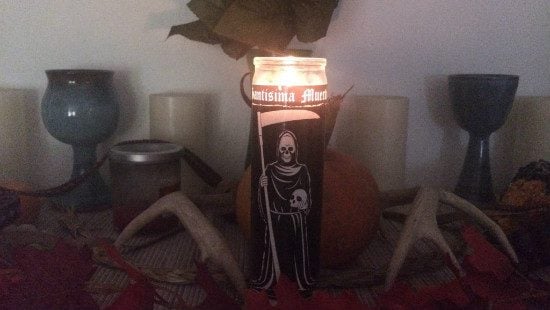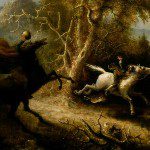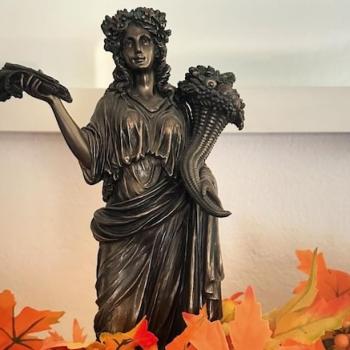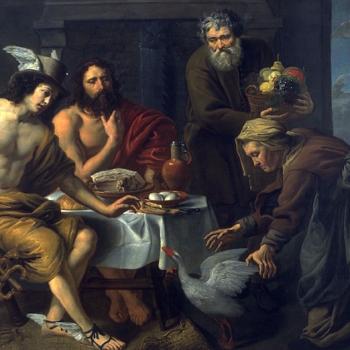The goddess and folk-saint Santa Muerte is quickly becoming one of the most beloved, and feared, deities in all of North America. Her rise to prominence has been incredibly fast, and yet she’s been around in various forms for perhaps thousands of years. Today her worship spans several religious traditions. She can be found in Catholic households, Santerian rites, and even the occasional Wiccan ritual.
My interest in Santa Muerte is tied directly to the land I currently call home. California was once a part of Mexico, and Mexican-culture is very much a part of California-culture. Candles depicting the Skeleton Saint are available at my local grocery store. To ignore her is to ignore the California I’ve come to love so much. I hesitate to call myself a devotee, but I can certainly feel her presence. As a goddess of death, everyone will eventually feel her presence, and she does not discriminate.
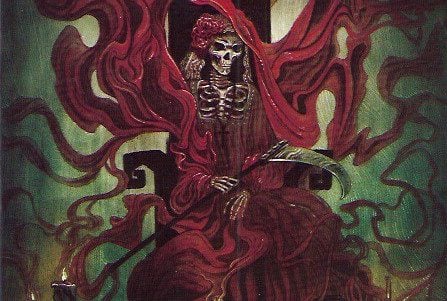
To many people Santa Muerte translates as “Saint Death,” with Santa being the feminine form of the word saint, and Muerte translating as death. But a more accurate translations is Holy Death, as santa also means holy. There’s also the pesky little fact that La Santa Muerte was never mortal like actual Catholic Saints (in most versions of her origin at least*). For those reasons Holy Death makes a lot more sense than Saint Death. (1)

I’m a firm believer that La Santa Muerte is somehow tied to Mictecacihuatl, but many scholars believe her most likely origin point is Western Europe and not Mexico. Images of the Grim Reaper were commonplace in Spain during the 16th and 17th Centuries and when the Spanish arrived in the Americas they brought the image with them. While we tend to think of the Grim Reaper as masculine, he was often depicted with a female assistant, La Parca. Eventually, so the theory goes, images of La Parca were misinterpreted and she ended up being mistaken for a saint. (3)
Do her origins lie with the Grim Reaper or with Mictecacihuatl? I think it’s possible that both a played a role in the development of Santa Muerte. It’s always much easier to hide an old faith in the clothes of the new. Perhaps Mictecacihuatl chose to stay with her children by adopting the iconography of La Parca? It’s all very difficult to determine because there’s a gap of several hundred years between the fall of the Aztec Empire in 1521 and the first recorded reference to Santa Muerte in the 1790’s.
READING ABOUT SANTA MUERTE
There are not a whole lot of books in English about Holy Death, which is why the footnotes below only contain two names. On the plus side the two most readily available books on La Santa Muerte are worth picking up and might even already be at your favorite bookstore.
The best place to start is with R. Andrew Chesnut’s Devoted to Death: Santa Muerte The Skeleton Saint (published in 2012 by Oxford University Press). Don’t let the “Oxford Press” stuff fool you, this is not an academic book. Sure, Chesnut is a college professor, but this is a popular history documenting the origins of Santa Muerte while going through the various roles she plays in folk-Catholicism. It’s also full of personal stories and some interviews with the people most prominent in Holy Death’s resurgence. If there’s a downside to this book it’s that it’s not long enough. It’s barely 200 pages, and a lot of the material is repeated throughout the book. I think I read a review once that said Devoted to Death reads more like a magazine article than a book, which is probably true. Reading Devoted to Death won’t help much when it comes to honoring the Boney Lady, but it does provide a detailed look at her followers.
For those looking to begin devotions to The Lady of the Shadows you probably want La Santa Muerte: Unearthing the Magic and Mysticism of Death by Tomaås Prower (Llewellyn Publications, 2015). This book isn’t so much about the history of our Lady, but about honoring and working with her. There are times when Unearthing the Magic tries a bit too hard to be all things (I didn’t really need an overview of death deities from various other pantheons) but the magic is solid and it’s obvious in his prose just how much Prower loves La Santa Muerte. One thing Prower does exceptionally well is open up the worship of Santa Muerte to anyone who hears her call. In his interpretation her worship is open to anyone and everyone. As a Wiccan I felt right at home in Prower’s world.
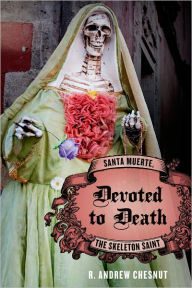 It’s probable that people were honoring Holy Death for hundreds of years before she was first written about, but that worship was most likely underground. The Catholic Church did not look favorably on Skeleton Saints (and Santa Muerte is not the only one) then or now, and her worship sites have been destroyed by church and government authorities many times over the centuries. In fact that destruction is a part of the first documented instance featuring Santa Muerte.
It’s probable that people were honoring Holy Death for hundreds of years before she was first written about, but that worship was most likely underground. The Catholic Church did not look favorably on Skeleton Saints (and Santa Muerte is not the only one) then or now, and her worship sites have been destroyed by church and government authorities many times over the centuries. In fact that destruction is a part of the first documented instance featuring Santa Muerte.
In 1779 30 members of the Chichimec people in present day Guanajuato were “caught” honoring Santa Muerte by local authorities. According to the official report the Chichimec would “at night gather in their chapel to drink peyote until they lose their minds; they light upside down candles, some of which are black; they dance with paper dolls; they whip Holy Crosses and also a figure of death that they call Santa Muerte, and they bind it with a wet rope and burn it if it does not perform a miracle.” (4) Holy Death’s shrine was demolished as punishment for such “idolatry.”
NICKNAMES OF HOLY DEATH
La Santa Muerte has many nicknames amongst her followers, some of the more popular include:
The Skinny Lady The White Girl The Boney Lady The Girl The Lady of the Shadows The Holy Girl
Prower lists several more names in his book, and gives a detailed explanation as to each nickname. Word of warning, many of these titles are meant to be terms of endearment and are usually only used by La Santa Muerte’s most devoted followers. In other words, don’t petition her as “The Girl” on your first go-around.
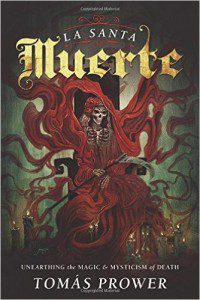 Santa Muerte then disappears from the historical record for over 150 years, next appearing in the late 1940’s. For many Santa Muerte is a Goddess of Death, but until fairly recently she was most likely to be invoked for matters of the heart. The Boney Lady is an expert on love, and is often asked to return a straying lover to their significant other. In the 1970’s one group of devotees is said to have chanted “Most Holy Death, torture him, mortify him” as they asked for the great Lady’s help with their significant others. (5)
Santa Muerte then disappears from the historical record for over 150 years, next appearing in the late 1940’s. For many Santa Muerte is a Goddess of Death, but until fairly recently she was most likely to be invoked for matters of the heart. The Boney Lady is an expert on love, and is often asked to return a straying lover to their significant other. In the 1970’s one group of devotees is said to have chanted “Most Holy Death, torture him, mortify him” as they asked for the great Lady’s help with their significant others. (5)
Worship of La Santa Muerte remained mostly underground until 2002 when an oversized statue of the folk-saint (a gift from her son) forced Enriqueta Romero to leave the front door of her house open so she’d have more room to work. As soon as people noticed the Bony Lady in Romoero’s home they asked if they could venerate her there. Very quickly her kitchen turned into a devotional space, along with Romero becoming one of the pivotal figures in the public acceptance of La Santa Muerte.
Today Santa Muerte is more likely to be associated with criminals than affairs of the heart, but much of that is due to our sensationalist media. Because Holy Death is an equal opportunity deity, she appeals to many on the margins of society, including drug traffickers and smugglers. As a result she’s often listed as a “Narco Saint” instead of as the universal figure she most definitely is. Unlike some saints (and even deities) La Santa Muerte is generally more interested in helping her followers than judging them, which explains why she’s so popular among the “Narcos.”
(One exception to the La Santa Muerte’s generally bad press was in the 2014 movie The Book of Life. No one ever comes right out and says that the female death goddess in the film is La Santa Muerte but I think it’s heavily implied. If you have yet to see The Book of Life you should attempt to remedy that situation.)
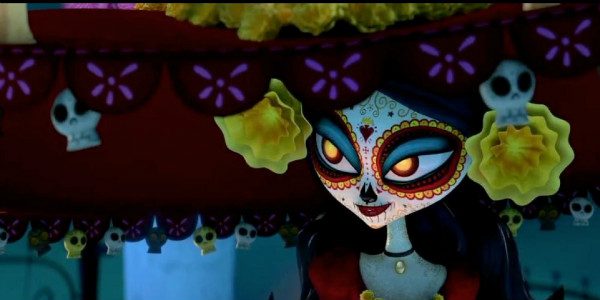
As her popularity has grown so to have her spheres of influence. In addition to love and death, La Santa Muerte is also a goddess of prosperity, justice, protection, and healing, and the list continues to grow, as does her cult. Worship of Holy Death is now widespread throughout the Americas, and is quickly becoming a world wide phenomenon.
Most of the Western World has a bad relationship with death. We often hide from it and try to ignore it. One of the many great things about Mexican culture is how open and honest it is about the other side of the veil. The idea of a skeleton saint is frightening to many in the United States and Europe, but the imagery and practices of Dia de los Muertos (The Day of the Dead) makes death, and by extension its matriarch, less frightening. I’m of the opinion that we could all use a little more Holy Death in our day to day lives.
*There is an interesting legend that claims Santa Muerte was born as a fully grown woman to a couple from the Purépecha tribe. In this story the girl who became Santa Muerte was extremely pale and beautiful and often wore white and black robes while wandering the countryside. Because of her beauty and wandering she was eventually tried for Witchcraft, and was sentenced to be burned to death. The flames took her life, but her skeleton emerged from the flames unharmed. (6)
ENDNOTES
1. Tomås Powers, La Santa Muerte: Unearthing the Magic & Mysticism of Death, Llewellyn Publications, page 36.
2. R. Andrew Chesnut, Devoted to Death: Santa Muerte the Skeleton Saint, Oxford University Press, page 28.
3. Chesnut page 30
4. Chesnut page 31
5. Chesnut page 34
6. Chesnut pages 29-30


